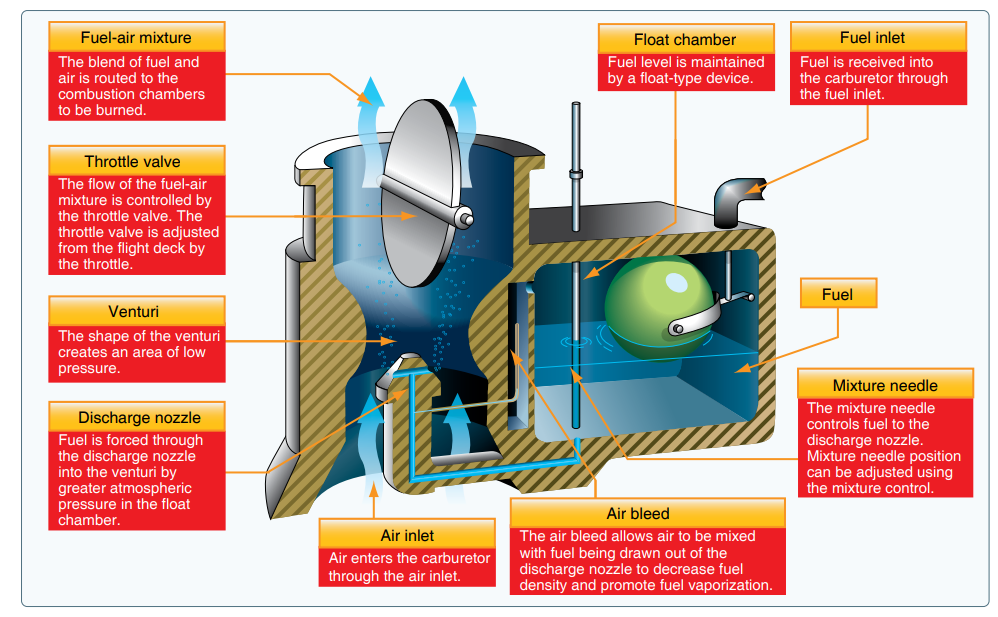Carburetors are supposedly volumetric (i.e. they’re supposed to deliver a constant air:fuel ratio by volume). As a consequence of the constant volume ratio, the mixture will automatically become richer when the air density decreases. Therefore, the mixture knob is used to restrict the flow of fuel to maintain the same mass flow ratio between fuel and air. This is how nearly every pilot is taught. But that explanation is not quite correct. Carburetors do not maintain a constant volumetric ratio of fuel and air. The fuel flow rate is actually related to the density of the air. As a result, the fuel flow actually declines as the air density declines. The problem is that it declines slower than the air density; this is what makes the mixture richer as we climb (or when reduce throttle).

Mathematics
As air flows through the carburetor’s constriction, the drop in pressure can be written as
\delta P = \frac{1}{2}\rho_a {v_a}^2 \hspace{2cm}(1)where \delta P is the pressure difference (compared to ambient), \rho_a is the density of air, and v_a is the velocity in the constriction. This pressure difference \delta P is what forces the fuel from the bowl into the venturi.
Next, we need to relate \delta P to the fuel draw rate. For this, we need to use the orifice plate equation, which states
Q_f = K\sqrt{2\delta P \rho_f}\hspace{2cm}(2)where Q_f is the gravimetric fuel flow rate, \rho_f is the fuel density and K is a function of the geometry of the orifice.
Combining the above two equations, we can get
Q_f = K\sqrt{\rho_a \rho_f}v_a.\hspace{2cm}(3)The velocity of air v_a is a function of engine rpm, engine displacement and the carburetor’s diameter. We can write this velocity as:
v_a = \frac{V f}{2D}\hspace{2cm}(4)where f is the engine rpm, V is the engine displacement volume, and D is the carburetor’s diameter. As a result, we can get
Q_f = \frac{KV f}{2D}\sqrt{\rho_a \rho_f}.\hspace{2cm}(5)The mass flow rate of air is
Q_a= \rho_a v_a =\frac{V f\rho_a}{2D}.\hspace{2cm}(6)Therefore, the ratio between the fuel flow rate (in mass) and the air flow rate (in mass) is
\frac{Q_f}{Q_a}= K \sqrt{\frac{\rho_f}{\rho_a}}.\hspace{2cm}(7)The square root dependence makes the ratio between fuel and air nonlinear with altitude.
We can assume that the fuel density remains more or less constant (although it does change slightly with temperature). Therefore, the only two variables here are the air density and the orifice geometry.
Example 1
Consider an aircraft climbing from sea level to 8000 ft with full open-throttle. The air density at 8000 ft is about 25% smaller than at sea level. Not accounting for temperature changes, the manifold temperature will drop by approximately 25%. From equation (7), assuming you leave the mixture setting unchanged (K remaining unchanged), we can see that the mixture will become richer by 15% (which comes from \sqrt{\frac{1}{0.75}}). We can restore the mixture by making the orifice smaller (which would make K smaller). This is exactly what the mixture knob does.
Notice that if the carburator had maintained a constant volumetric ratio of air to fuel, the mixture would be richer by 25%, not 15%.
Example 2
Next, lets look at a change in throttle setting at the same altitude. An ideal example of this is taxiing vs takeoff. Looking at equation (7), we might be tempted to conclude that throttle setting has no relationship to the mixture setting. But the important point to remember is that air density \rho_a is related to manifold pressure. \rho_a will be equal to ambient density only when the throttle is wide open. With the throttle at a low setting, the intake manifold pressure will be low, leading to a lower air density value \rho_a. For example, taxiiing at 10″ of manifold pressure is equivalent to flying with a wide open throttle at 28,000 ft. Following the same argument as before, this would lead to a richer mixture. For example, if the mixture is set correctly for takeoff power at sea level manifold pressure, during taxiing at 10″ of manifold pressure, the mixture will be richer by 70% (which comes from \sqrt{\frac{29}{10}}).
Assumptions
In the above discussion, we have assumed a single value of air density \rho_a. In fact, \rho_a in equation (1) is actually the air density in the venturi, and the \rho_a in equation (6) is the air density in the intake manifold. These are not exactly the same. The air density in the venturi will be higher than in the manifold.
We are also assuming that our goal is to maintain a fixed air:fuel ratio. This is not always the case. The stoichiometric mass flow ratio for complete combustion is 1:14.7. That is, we need 14.7 grams of air for each gram of fuel. However, due to other factors such as cooling and combustion efficiency, the ideal mass flow ratio is not always 1:14.7. At very high power outputs, it is better to use something like 1:12 (which is known as rich of peak) and at low power settings it is more efficiency to use something like 1:16 (known as lean of peak). As a result, even if there is no change in air density, the mixture should be adjusted whenever there is a change in power. On takeoff, the mixture should be slightly enriched. Once the power is reduced after take-off, the mixture can be leaned.
Leave a Reply